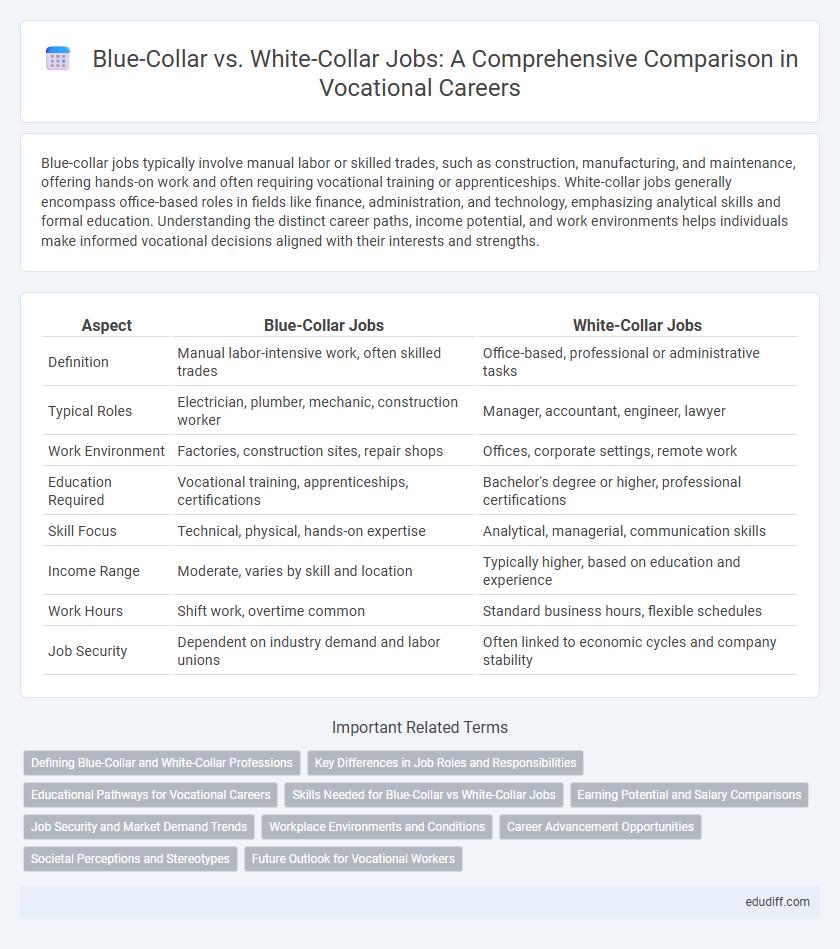Blue-collar jobs typically involve manual labor or skilled trades, such as construction, manufacturing, and maintenance, offering hands-on work and often requiring vocational training or apprenticeships. White-collar jobs generally encompass office-based roles in fields like finance, administration, and technology, emphasizing analytical skills and formal education. Understanding the distinct career paths, income potential, and work environments helps individuals make informed vocational decisions aligned with their interests and strengths.
Table of Comparison
| Aspect | Blue-Collar Jobs | White-Collar Jobs |
|---|---|---|
| Definition | Manual labor-intensive work, often skilled trades | Office-based, professional or administrative tasks |
| Typical Roles | Electrician, plumber, mechanic, construction worker | Manager, accountant, engineer, lawyer |
| Work Environment | Factories, construction sites, repair shops | Offices, corporate settings, remote work |
| Education Required | Vocational training, apprenticeships, certifications | Bachelor's degree or higher, professional certifications |
| Skill Focus | Technical, physical, hands-on expertise | Analytical, managerial, communication skills |
| Income Range | Moderate, varies by skill and location | Typically higher, based on education and experience |
| Work Hours | Shift work, overtime common | Standard business hours, flexible schedules |
| Job Security | Dependent on industry demand and labor unions | Often linked to economic cycles and company stability |
Defining Blue-Collar and White-Collar Professions
Blue-collar professions typically involve manual labor and skilled trades such as construction, manufacturing, and maintenance, where workers often operate machinery or perform physical tasks. White-collar jobs primarily encompass office-based roles like management, administration, finance, and information technology, focusing on cognitive skills and decision-making. Understanding the distinctions in work environment, required skill sets, and typical job functions helps clarify the vocational paths and career opportunities characteristic of each category.
Key Differences in Job Roles and Responsibilities
Blue-collar jobs primarily involve manual labor and skilled trades such as construction, manufacturing, and maintenance, emphasizing physical tasks and technical expertise. White-collar jobs typically encompass professional, managerial, and administrative roles requiring analytical skills, decision-making, and office-based work environments. Key differences in responsibilities include blue-collar workers engaging in hands-on problem-solving and machinery operation, while white-collar employees focus on strategic planning, data analysis, and communication.
Educational Pathways for Vocational Careers
Blue-collar jobs typically require vocational training, apprenticeships, or certifications focused on technical skills such as welding, plumbing, or electrical work. White-collar jobs often demand higher education degrees in fields like business management, engineering, or information technology, sometimes complemented by internships or professional development courses. Vocational education bridges these paths by providing practical, hands-on training tailored to specific trades, enabling faster entry into the workforce with specialized expertise.
Skills Needed for Blue-Collar vs White-Collar Jobs
Blue-collar jobs typically require hands-on technical skills, physical strength, and specialized trade knowledge such as welding, plumbing, or electrical work, often gained through apprenticeships or vocational training. White-collar jobs emphasize analytical thinking, communication skills, and proficiency in office software, usually obtained via formal education in business, finance, or technology fields. Both sectors demand problem-solving abilities, but blue-collar roles rely more on manual dexterity and practical experience while white-collar roles focus on cognitive and administrative competencies.
Earning Potential and Salary Comparisons
Blue-collar jobs often offer competitive hourly wages, especially in skilled trades like welding, electrical work, and plumbing, with some positions exceeding $60,000 annually. White-collar jobs typically provide higher average salaries, with many roles in management, finance, and technology surpassing $80,000 per year, driven by advanced education and specialized skills. Salary comparisons reveal blue-collar workers can earn comparable or higher incomes when factoring overtime, certifications, and union benefits, narrowing the pay gap with many lower-level white-collar positions.
Job Security and Market Demand Trends
Blue-collar jobs, often found in manufacturing, construction, and skilled trades, generally offer strong job security due to consistent demand in essential industries and growing infrastructure projects. White-collar jobs, commonly in sectors like finance, technology, and healthcare, show increasing market demand driven by digital transformation and professional services expansion. Trends indicate blue-collar positions benefit from stable employment opportunities, while white-collar roles adapt rapidly to technological advancements and economic shifts.
Workplace Environments and Conditions
Blue-collar jobs typically involve manual labor in industrial, manufacturing, or construction settings, where physical effort and safety protocols are critical. White-collar jobs are primarily conducted in office environments, characterized by administrative, managerial, or professional tasks requiring mental skills and ergonomic workstations. Workplace conditions for blue-collar roles often include exposure to noise, machinery, and fluctuating temperatures, while white-collar environments favor climate-controlled offices with technology-driven tools.
Career Advancement Opportunities
Blue-collar jobs often provide career advancement through skill specialization, certifications, and apprenticeships, enabling workers to move into supervisory or technical expert roles. White-collar jobs typically offer advancement via formal education, professional development, and managerial track progression within corporate or administrative settings. Both sectors emphasize ongoing training and networking as key factors for career growth.
Societal Perceptions and Stereotypes
Societal perceptions often stereotype blue-collar jobs as physically demanding but less prestigious, while white-collar jobs are viewed as intellectually superior and more socially esteemed. These stereotypes overlook the essential skills and economic contributions of blue-collar workers, reinforcing class divides and limiting vocational appreciation. Addressing these biases is crucial for promoting equal respect and opportunities across all occupational fields.
Future Outlook for Vocational Workers
Vocational workers in blue-collar jobs are projected to see increased demand due to growing needs in skilled trades such as electricians, plumbers, and HVAC technicians, driven by infrastructure development and technological upgrades. White-collar jobs, while expanding in sectors like IT and management, often require advanced degrees and continuous upskilling, potentially limiting access for vocational workers without formal higher education. Automation and AI pose challenges, but hands-on vocational expertise remains critical in areas requiring physical skills and problem-solving, ensuring sustained employment opportunities.
Blue-Collar Jobs vs White-Collar Jobs Infographic

 edudiff.com
edudiff.com